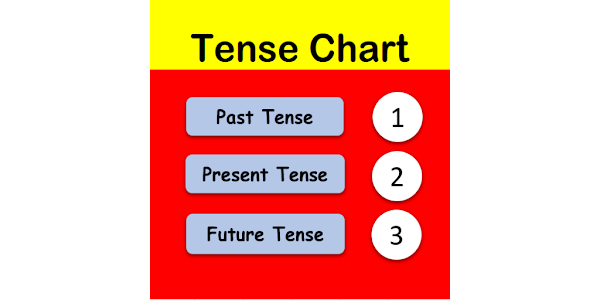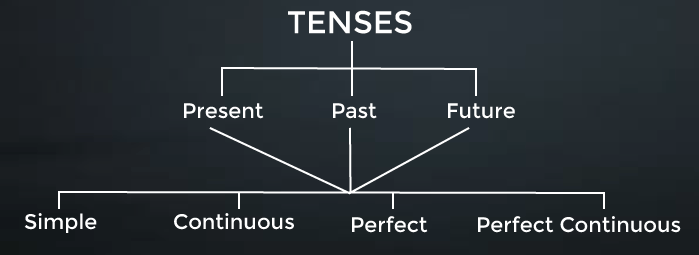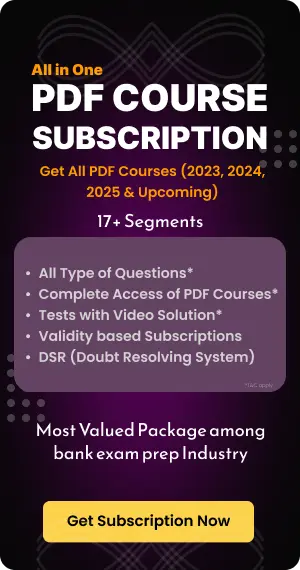Tenses Chart in English Grammar PDF: Check with Definition, Types, Rules, Formulas and Examples
Nov 13 2025
What is a Tense? A Tense is a form of the verb that expresses time. The tense indicates when an event occurred or when an action was performed. The three primary types of tenses are past, present, and future. Understanding tenses is a crucial skill when learning the English language. It plays an important role in both spoken and written communication by helping us clearly specify when something took place. Furthermore, there are additional aspects that provide more details, such as the duration of the action, the sequence of events, or whether a past event influences the present. These grammatical aspects encompass the simple tense, perfect tense, continuous tense, and perfect continuous tense.
For those studying for exams like Banking, SSC, Railway, UPSC, Defence, Insurance, and State PCS, it is essential to have a strong understanding of tense rules, as this knowledge benefits not only grammar-related questions but also enhances descriptive writing, essays, and overall communication abilities.
This article offers a comprehensive tenses chart in English grammar, detailing their definitions, types, rules, formulas, and examples in a clear and exam-friendly manner. A downloadable PDF (available in English and Hindi) is also provided to facilitate quick and confident revision! For any questions, please refer to the FAQ section below.
Click Here to Tenses Chart In English Grammar PDF Free Download
Tenses Chart In English Grammar In Hindi PDF Free Download → Click Here
Root Words In English Vocabulary PDF
Tenses Definition
In English, Verbs are mainly used to represent Past, Present, and Future actions or states of an event.
-
When verbs are changed over time, such verbs are called Tenses.
-
The right usage of tenses makes the passage's context correct and distinct.
-
There are three different types of Tenses in English Grammar.
-
They are the Present tense, the Past tense, and the Future tense.
-
These three types of tenses are further classified into four subtypes they are Simple tense, Continuous tense, Perfect tense, and Perfect Continuous tense.

Opposite Words in English A To Z PDF Download
Tenses Chart In English Grammar - Rules
The table given below explains the tenses with rules in English. The given tenses chart in English grammar with formulas helps you to understand the logic behind the usage of tenses in English Grammar.
Banking English PDF: Download the Free English PDF for the Banking Exam
Rules/Formulas of Tenses Chart in English Grammar |
|||
Tenses |
Present |
Past |
Future |
Simple |
V1 or V1 + s/es Is/Am/Are |
V2 |
Will + Verb |
Continuous |
Is/Am/Are + V1+ing |
Was/Were + V1+ing |
Will be + V+ing |
Perfect |
Has/ Have + V3 |
Had + V3 |
Will have + V3 |
Perfect Continuous |
Has/Have been + V1+ing + Since/For |
Had been + V1+ing + Since/For |
Will have been + V+ing + Since/For |
Download the English Grammar Rules PDF For Competitive Exams
Tenses Chart in English Grammar - Hindi
The table will be updated soon to explain the tenses chart in English grammar with rules in Hindi. The tenses chart with formulas helps you to understand the logic behind the usage of tenses chart in English Grammar in the Hindi language.
Tense Types In English
In English Grammar, there are three different types of tenses in English. They are as follows,
-
Present Tense
-
Past Tense
-
Future Tense
The above three tenses are further classified into four subtypes. So, there are 12 tenses in the tenses chart in English Grammar. They are classified in the chart given below.

Tense Types In English |
|||
Tenses |
Present |
Past |
Future |
Simple |
Simple Present |
Simple Past |
Simple Future |
Continuous |
Present Continuous |
Past Continuous |
Future Continuous |
Perfect |
Present Perfect |
Past Perfect |
Future Perfect |
Perfect Continuous |
Present Perfect Continuous |
Past Perfect Continuous |
Future Perfect Continuous |
English Mastery PDF Course 2024
Tense Types With Examples
To gain complete knowledge about the tenses chart in English Grammar, you can read the given tenses types and examples.
Tense Types With Examples |
||
Tenses |
Types |
Examples |
Present Tense |
Simple Present Tense |
She writes a letter. |
|
Perfect Present Tense |
She has written a letter. |
|
|
Continuous Present Tense |
She is writing a letter. |
|
|
Perfect Continuous Present Tense |
She has been writing a letter since yesterday. |
|
Past Tense |
Simple Past Tense |
She wrote a letter. |
|
Perfect Past Tense |
She had written a letter. |
|
|
Continuous Past Tense |
She was writing a letter. |
|
|
Perfect Continuous Past Tense |
She had been writing the letter since morning. |
|
Future Tense |
Simple Future Tense |
She will write a letter. |
|
Perfect Future Tense |
She will have written a letter. |
|
|
Continuous Future Tense |
She will be writing a letter. |
|
|
Perfect Continuous Future Tense |
She will have been writing the letter at 8 am tomorrow. |
|
Verb Forms With Examples
From the given examples of the verb list, you can get an idea of the three forms of verbs in English grammar. The given verb forms v1,v2, and v3 play an important role in tenses. These given verb examples are verb words used in English grammar.
Verb Forms With Examples |
||
Base Form |
Past Form |
Past Participle |
V1 |
V2 |
V3 |
|
arise |
arose |
arisen |
|
bite |
bit |
bitten |
|
burn |
burnt |
burnt |
|
cut |
cut |
cut |
|
drink |
drank |
drunk |
Tenses chart in English grammar
Here, we discuss the twelve types of tenses in English Grammar with rules and examples.
1. Present Tense
The Present tense is defined as the form of a verb that expresses an action or event that is currently occurring or happening in the present moment. The tense chart of the Present Tense is discussed below.
Types of Present Tense
There are four types of the Present Tense in English Grammar. They are
1) Simple Present Tense
2) Present Continuous Tense
3) Present Perfect Tense
4) Present Perfect Continuous Tense
1) Simple Present Tense
Rule/Formula
| Subject + Verb (Base Form)/ Third Person Plural Form + Object |
Examples:
-
He goes to the gym.
-
We live in Australia.
-
Kavita writes a letter.
2) Present Continuous Tense
Rule/Formula
| Subject + Helping Verb (am/is/are) + Main Verb + ing + Object |
Examples:
- She is reading a book.
- I am studying.
- Kamala is singing a song.
3) Present Perfect Tense
Rule/Formula
| Subject + Helping Verb (have/has) + Past Participle of Main Verb + Object |
Examples:
- You have played well.
- She has read storybooks.
- They have watched these cartoons.
4) Present Perfect Continuous Tense
Rule/Formula
| Subject + Have/Has + Been + Verb + ing + Object |
Examples:
- You have been playing all day.
- I have been working on this project.
- She has been reading storybooks.
2. Past Tense
The Past tense is defined as the form of a verb that expresses an action or event that already happened or occurred in the past. The tense chart of the Past Tense is discussed below.
Types of Past Tense
There are four types of Past tenses in English Grammar. They are
1) Simple Past Tense
2) Past Continuous Tense
3) Past Perfect Tense
4) Past Perfect Continuous Tense
1) Simple Past Tense
Rule/Formula
| Subject + Verb+ed/ Verb in Past Tense (V2) + Object |
Examples:
- We lived in Australia.
- He went to the gym.
- Kamala sang a song.
2) Past Continuous Tense
Rule/Formula
| Subject + Helping Verb (was/were) + Main Verb + ing + Object |
Examples:
- We were going to Australia.
- He was going to the gym.
- Kamala was singing a song.
3) Past Perfect Tense
Rule/Formula
| Subject + Helping Verb (had) + Past Participle of Main Verb(V3) + Object |
Examples:
- We had gone to Australia.
- He had gone to the gym.
- Kamala had sung a song.
4) Past Perfect Continuous Tense
Rule/Formula
| Subject + Had + been + Verb + ing + Object |
Examples:
- We had been visiting Australia.
- He had been going to the gym.
- Kamala had been singing a song.
3. Future Tense
The Future tense is defined as the form of a verb that expresses an action or event that has not yet happened or is expected to happen or occur in the future. The tense chart of the Future Tense is discussed below.
Types of Future Tense
There are four types of Future tenses in English Grammar. They are
1) Simple Future Tense
2) Future Continuous Tense
3) Future Perfect Tense
4) Future Perfect Continuous Tense
1) Simple Future Tense
Rule/Formula
| Subject + will/shall + Verb (V1)+ Object |
Examples:
- We shall live in Australia.
- He will go to the gym.
- Kamala will sing a song.
2) Future Continuous Tense
Rule/Formula
| Subject + will/shall + be + Verb + ing + Object |
Examples:
- We shall be going to Australia.
- He will be going to yoga class.
- Kamala will be singing a song.
3) Future Perfect Tense
Rule/Formula
| Subject + will/shall + have + Verb (V3)+ Object |
Examples:
- We shall have left Australia.
- He will have gone to the gym.
- Kamala will have sung a song.
4) Future Perfect Continuous Tense
Rule/Formula
| Subject + will/shall + have + been + Verb + ing + Object |
Examples:
- We shall be going to Australia.
- He will have been going to the gym.
- Kamala will have been singing a song.
Grand Bundle PDF Course For the English Language
Tenses Chart in English Grammar - FAQs
Q. What is a tense in English grammar?
Tense refers to the form of a verb that shows the time of an action or event — whether it happened in the past, is happening now, or will happen in the future.
Q. Why is learning tenses important for competitive exams?
Tenses help you frame grammatically correct sentences in essays, letters, and comprehension tasks, and they’re directly tested in error spotting, sentence improvement, and cloze tests.
Q. How many tenses are there in English grammar?
There are three main tenses: Present, Past, and Future. Each tense has four aspects: Simple, Continuous, Perfect, and Perfect Continuous, making 12 tenses in total.
Q. What is the formula for the Present Simple tense?
Subject + base verb (s/es for 3rd person singular), Example: She writes daily.
Q. When do we use the Past Simple tense?
To describe actions completed in the past at a specific time. Example: He visited Delhi last year.
Q. What is the structure of the Present Continuous tense?
Subject + am/is/are + verb + ing, Example: I am studying.
Q. When is the Past Continuous tense used?
To describe an action that was ongoing at a particular time in the past. Example: They were watching a movie at 8 PM.
Q. What is the formula for the Present Perfect tense?
Subject + has/have + past participle, Example: She has completed her homework.
Q. What is the use of the Future Perfect tense?
To describe an action that will be completed before a specific point in the future. Example: By 2025, he will have finished his degree.
Q. How is the Present Perfect Continuous tense formed?
Subject + has/have been + verb + ing, Example: We have been working since morning.
General Awareness Smart Analysis (Smart Quiz 2.0)
- Get Weekly 4 set Test
- Each Set consist of 50 Questions
- Compare your progress with Test 1 & 2 & Test 3 & 4
- Deep Analysis in topic wise questions
Super Plan
- All Banking PDF Course 2026, 2025, 2024
- All Banking Video Course
- All Banking Mock Test Series
- All Banking Bundle PDF Courses
- All Banking Ebooks
- All Banking Interview Courses Not Included
Premium PDF Course
- Bundle PDF Course 2025
- Premium PDF Course 2024
- Prime PDF Course 2023







